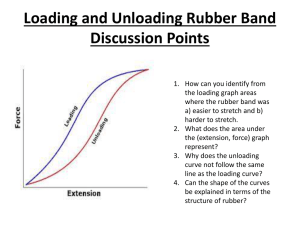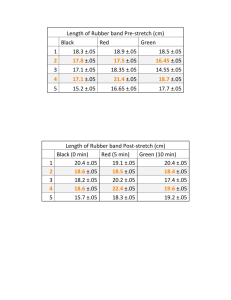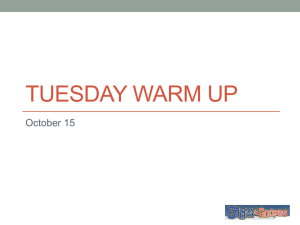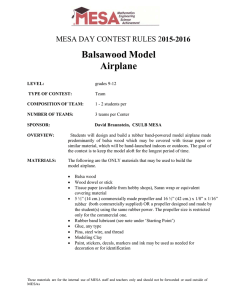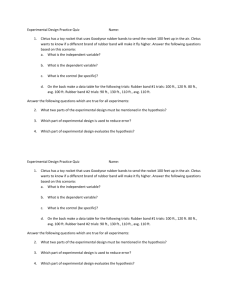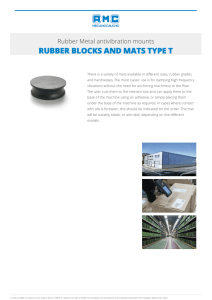Power Point Presentation - Physics 420 UBC Physics Demonstrations
advertisement
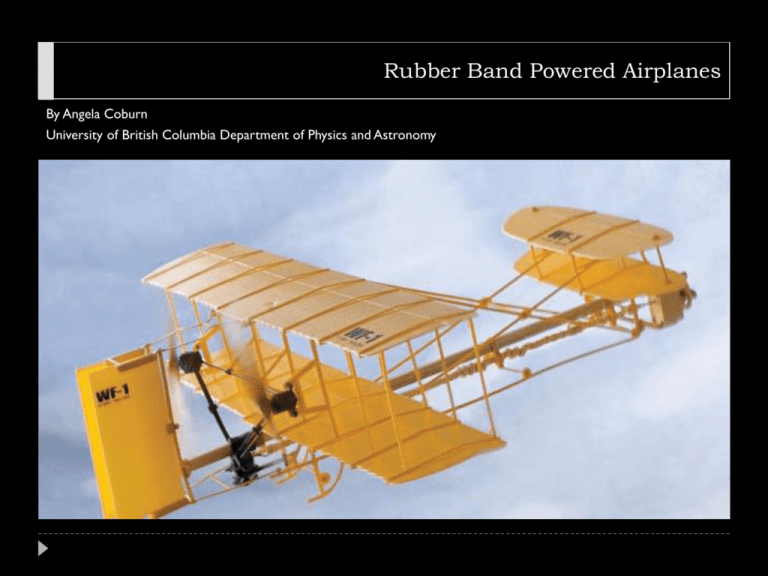
Rubber Band Powered Airplanes By Angela Coburn University of British Columbia Department of Physics and Astronomy Outline History of Rubber Powered Aircraft Newton’s Second and Third Law’s Four Forces Acting on an Airplane Energy, Work and Power Transport Cost Calculations Building Airplanes Summary History of Rubber Powered Aircraft 1903 – Wright brothers made the first human flight. As children they received a rubber powered toy helicopter. When they broke it they started building their own. This began their life long interest in flight. History of Rubber Powered Aircraft 1871- Alphonse Penaud flew a rubber-powered aircraft called the planophore for 131 feet in 11 seconds. first really stable aircraft, making it one of the most important inventions leading up to the invention of the airplane. History of Rubber Power Aircraft Became an important research tool for aerodynamic engineers, as it allowed them to test numerous configurations of: • wings • rudders • elevators • fuselages for airworthiness Newton’s Law’s of Motion Newton’s second law states that if the forces on an object are unbalanced then its motion will change. The bigger the force, the bigger the change in motion or acceleration. F=ma (Force= mass X acceleration) Newton’s Law’s of Motion Newton's Third Law of Motion says that when two objects push or pull against each other, the forces that they feel are equal and opposite. Four Forces Acting on an Airplane How does a propeller make the aircraft move forward? The engine turns the propeller. The propeller is specially shaped to push the air backwards. This results in a reaction force on the propeller that moves the aircraft forwards. (Thrust). Energy Energy: The ability of an object do work. Has units of Joule (J) or newton-meter (Nm). Kinetic Energy: Energy of motion. KE=1/2mv2 Potential Energy: Stored energy. Ug=mgh Work and Energy Work: The amount of energy transferred by a force acting through a distance. Unit of Joule (J). W=F∙d What about for our model airplane? Work Done by the Propeller The distance around the edge of a circle (or any curvy shape) is the circumference: C = 2πr We must also count the number of times the propeller travels around the circle. Distance = (2πr) x turns Power and Steady State Power: The time rate of energy transfer. Unit of Watt (W) or J/s. P=W/t Steady State: to maintain an aircraft in flight, the power input has to be equal to the power output to its surroundings. Calculations Using some of the equations and concepts we have just learned, let’s calculate the potential energy stored in the rubber band. Our Model Airplane Recall that the propeller provides the thrust to move the plane horizontally. In the model, potential energy is stored in the twisted rubber band powering the propeller. When the rubber band untwists, kinetic energy is released and work is done in turning the propeller. Thus, the potential energy stored in the rubber band will be equal to the work. Model Airplane Recall that Work= Force X distance How can we measure the force the rubber band exerts on the propeller? F=mass x acceleration (9.8m/s2) What about the distance? d= 2πr (number of turns) For our model: W= F x (2πr) (number of turns) Energy stored in Rubber Band 0.7 0.6 Potential Energy (Joules) 0.5 0.4 Winding Up Winding Down 0.3 0.2 0.1 0 0 50 100 150 200 Number of Turns 250 300 350 Model Airplane Why is the energy stored in the rubber band different when we measure it again after winding the propeller back down? Some of the energy was lost to heat in the rubber band! Model Airplane Now that we have calculated the work, let’s calculate the power. How can we do this? Power = Work/time Power 0.06 0.05 Power (Watts) 0.04 0.03 Winding Up Winding Down 0.02 0.01 0 0 50 100 150 200 Number of Turns 250 300 350 Transport Cost This is the most important measure of energy use in transportation. Energy consumed per unit mass per unit distance travelled. Measure of energy. Units of J/kg/m or kWh/tonne/km. Transport cost of a model airplane Distance travelled Measurement 4.3 m Height drop Measurement 1.4 m Glide slope Height/Distance g Transport cost 0.325581395 9.8 m/s2 =PE/ mgh/d = g*(glide slope) Transport cost Transport Cost of 747 is 0.5 kWh/tonne/km 3.190697674 J/kg/m 0.89 kWh/tonne/km MJ/tonne/km Let’s build some airplanes!

